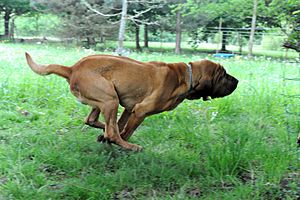Sleuth hound facts for kids
The sleuth hound was a special type of dog from Scotland. It was very good at tracking things, especially people. Many people in England called this dog a Bloodhound. The name "sleuth hound" comes from an old Norse word meaning "track" or "trail." Sometimes, people also called it a "slough dog" or "slow hound," but it wasn't slow at all!

Contents
History of the Sleuth Hound
Tracking Heroes in Old Tales
The sleuth hound first appeared in old Scottish poems. These poems were about famous Scottish heroes like Robert the Bruce and William Wallace. The stories said that these heroes were tracked by sleuth hounds. For example, Robert the Bruce escaped by crossing water. William Wallace tricked a hound by leaving a body behind to distract it. These poems were exciting stories, not always true history.
Early Records of the Dog
A writer named John Barbour wrote a poem called The Bruce. He was born before Robert the Bruce died. The poem talks about Bruce being chased by a sleuth hound around 1307. This means these dogs were used in Scotland as early as c. 1300. They were already known for tracking people.
What Was a Sleuth Hound Like?
First Descriptions
The earliest detailed description of the sleuth hound came in 1536. It was in a book called The history and croniklis of Scotland. This book was a translation by John Bellenden of a Latin text. The original Latin book was written by Hector Boece in 1526.
Special Abilities
Boece's book described the sleuth hound as one of three special dog types in Scotland. It said the dog was red or black. It often had small spots. Its most amazing quality was its incredible sense of smell. It was also very determined. These dogs were famous for chasing thieves, especially those known as Border Reivers.
Laws About Sleuth Hounds
There were even laws about these dogs near the border between Scotland and England. If someone refused to let a sleuth hound enter their property while it was chasing stolen goods, that person was considered a helper of the thief. This shows how important these dogs were for law enforcement back then.
Sleuth Hound and Bloodhound
Are They the Same Dog?
A writer named John Caius described similar dogs in England. He wrote about the English bloodhound in 1576. These dogs were used in very similar ways on the borders. This made people think that the Bloodhound and the sleuth hound were the same animal.
Small Differences
In 1554, a book published in Switzerland also called the sleuth hound "blüthund." It also called it "canis Scoticus furum deprehensor," which means "Scottish dog, thief catcher." Many texts from that time agreed they were the same dog. However, the Bloodhound was usually a bit bigger. It also had more coat colors than the sleuth hound. Sleuth hounds were mostly mentioned for tracking people. Bloodhounds were used for tracking people and for hunting animals.
The Name Change
Around the 1700s, any small differences between the two dogs disappeared. "Bloodhound" became the common name, even in Scotland. Famous Scottish writers like Sir Walter Scott started using "Bloodhound."
Modern Use of "Sleuth"
The Scottish term "sleuth" still lives on today. From the early 1800s, it started being used in a different way. It became a word for a detective. Now, it's often shortened to just "sleuth." So, when you hear "sleuth," you're thinking of someone who tracks down clues, just like the old sleuth hounds!

